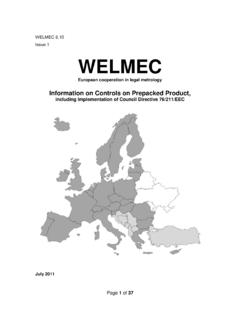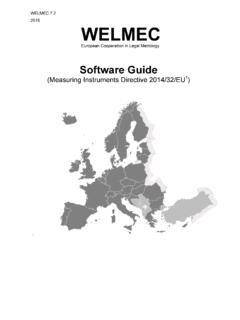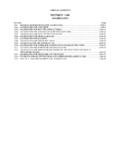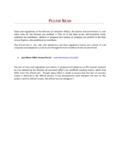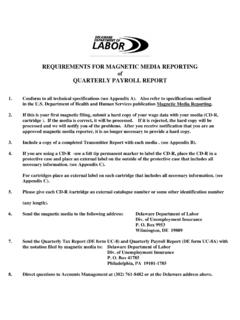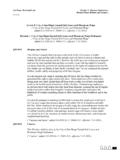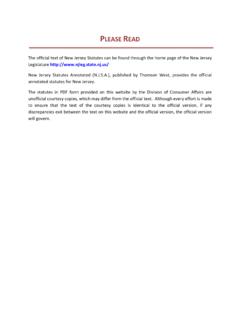Transcription of WELMEC 2.3 Issue 3 WELMEC
1 WELMEC Issue 3 WELMEC . European co-operation in legal metrology Guide for Examining Software (Non-automatic Weighing Instruments). May 2005. WELMEC . European cooperation in legal metrology WELMEC is a cooperation between the legal metrology authorities of the Member States of the European Union and EFTA. This document is one of a number of Guides published by WELMEC to provide guidance to manufacturers of measuring instruments and to notified bodies responsible for conformity assessment of their products. The Guides are purely advisory and do not themselves impose any restrictions or additional technical requirements beyond those contained in relevant EC. Directives. Alternative approaches may be acceptable, but the guidance provided in this document represents the considered view of WELMEC as to the best practice to be followed.
2 Published by: WELMEC Secretariat BEV. Arltgasse 35. A-1160 Vienna Austria Tel: +43 1 21176 3608. Fax: +43 1 49 20 875. Email: Website: 2. Contents 1. 4. Background .. 4. General 4. Scope .. 5. Conception .. 7. 2. Terminology .. 8. Legally relevant 8. Changes of 10. Protection of 10. 3. Software requirements .. 10. Protection of the legally relevant 10. Software 11. Software identification .. 12. Documentation .. 13. 4. Report on the Software 13. 5. Required Specifications in 13. 6. Preliminary Procedure .. 14. Annex I Checklist to Report on the Software Examination .. 15. Annex II Software Download on Non-automatic Weighing 17. 3. 1. Introduction Background The EC Directive 90/384/EEC states some essential requirements for the protection against changes, manipulation or fraudulent use of non-automatic weighing instruments (NAWIs).
3 Which, in principle, have to be applied also to the software controlling these instruments: (i) Annex I, No , Directive 90/384/EEC: Design and construction of the instruments shall be such that the instruments will preserve their metrological qualities when properly used and installed, and when used in an environment for which they are (ii) Annex I, No , Directive 90/384/EEC: The instruments shall have no characteristics likely to facilitate fraudulent use, whereas possibilities for unintentional misuse shall be minimal. Components that may not be dismantled or adjusted by the user shall be secured against such actions. (iii) Annex II, No. , Directive 90/384/EEC: The applicant shall keep the notified body that has issued the EC type-approval certificate informed of any modification to the approved In the practice of type examination of NAWIs by the various European Notified Bodies, it has become apparent that the above essential requirements needed a uniform interpretation with regard to intelligent, user-accessible (freeprogrammable) peripheral devices or modules of NAWIs, such as PC-based indicators, data storage devices or point of sales devices (POS).
4 The item of Software requirements for NAWIs' was raised at the 7th WG2 meeting on 23 February 1994 where a respective discussion paper and questionnaire of the PTB was circulated. The results were discussed at the 8th WG2 meeting at SP in Bor s on 6/7 June 1994, where it was decided to cooperate with CECIP (the European Committee of manufacturers of weighing instruments) on this matter. A WG2 subgroup was constituted, consisting of CECIP, DADTI (Denmark), DELTA. (Denmark), NMi (the Netherlands), NWML (UK), PTB (Germany), SDM (France) and SP. (Sweden). On the occasion of a subgroup meeting in Berlin on 5/6 September 1994, a consensus of all participants - including CECIP - was achieved about a 5 point catalogue of software requirements for freeprogrammable, PC-based modules or peripheral devices which are linked to, or form part of, NAWIs subject to legal control.
5 On the basis of this catalogue, a draft of requirements on software for NAWIs subject to legal control' was worked out which was circulated among all subgroup members and finally discussed and its principles agreed upon at the 9th WELMEC WG2 meeting in Brussels, 22/24 November 1994. Both sides, the representatives of the Notified Bodies responsible for type examinations of NAWIs and the representatives of CECIP fully agreed that there was a very urgent need for a Guide for examining software for non-automatic weighing instruments (NAWI) , and that such a document should be issued in order to gain experience and knowledge with the approach presented hereafter. General considerations The European Standard on non-automatic weighing instruments, EN 45501, specifies the metrological and technical requirements for non-automatic weighing instruments subject to legal metrological control in order to meet the essential requirements of EC Directive 90/384/EEC.
6 The requirements of this European Standard apply to all devices performing the relevant functions, whether integrated in an instrument or manufactured as a separate unit (see EN 45501, point ). 4. A problem with the software of weighing instruments, modules or peripheral devices is that this standard does not describe the relevant requirements and examinations to be applied to the software of these instruments or modules and how the result of the examination is to be documented. This guide tries to fill this gap with regard to software for freeprogrammable, PC-based devices which are linked to, or form part of, NAWIs subject to legal control. The basic intention of this Guide is to: Describe essential properties of the software rather than technical solutions. Offer an effective, but not an extensive protection against manipulation and simulation of the software performing legally relevant functions.
7 Harmonise software examination and documentation by the Notified Bodies as part of the type approval and testing procedures for NAWIs and related modules or peripheral devices. This approach takes into consideration the interests and responsibilities of both the manufacturer and the Notified Body. The manufacturer has a vital interest not only in the flexibility of his instrument but also in its protection against any misuse as far as he is liable for his product; this includes his responsibility for the conformity of the individual instrument to the approved type. The Notified Body by law is forced to examine thoroughly the conformity of a type with EC regulations and the measures taken to protect the customer of an instrument against wrong measurement, unintentional misuse and fraudulent use.
8 Scope This guideline specifies basic requirements to be applied to software for freeprogrammable, PC-based modules or peripheral devices which are linked to, or form part of, NAWIs subject to legal control (see notes under section 6 Preliminary procedure ). The Figures 1 and 2 schematically illustrate the structures of the hardware and software of a PC-based weighing system comprising devices and functions subject to legal control (inside the circles) and others not subject to legal control (outside the circles). Both figures are intended to serve as examples in order to demonstrate the basic principles of this guideline rather than as sophisticated models that cover all possible technical solutions. Therefore, they have to be interpreted with close regard to the requirements of the Directive 90/384/EEC and the European Standard EN 45501, respectively.
9 5. Figure 1: Example of a hardware structure of a PC-based weighing system;. CU currency unit Figure 2: Example of a software structure of a PC-based weighing system 6. The basic instrument is the NAWI comprising at least a load cell, a load receptor, a microprocessor system including an A/D converter and a weight display. The basic instrument, if need be in combination with separate modules or peripheral devices, may perform further functions subject to legal control, such as price calculation, price indication, printing or storing of weighing results and other functions, eg. tare balancing, preset tare. Other peripheral devices not subject to legal control may be connected to the NAWI if the respective hardware interfaces are protective in the sense of EN 45501, Section A freeprogrammable PC-based module or peripheral device will not be subject to legal control if it communicates with the NAWI via a protective hardware interface and if it does not carry out any legally relevant function.
10 But today, freeprogrammable modules and peripheral devices - for example POS devices - take over more and more legally relevant functions from the NAWI, eg. printing of weighing results or price calculation. In this case, the hardware of the PC-based device is subject to legal control (see Figure 1). The software of such a device performs both functions subject to legal control and others not subject to legal control (see Figure 2). The scope of this guide is to define the basic requirements to be met by the software of a PC-based device in order to have a freeprogrammable software part which can be adapted to the special needs of a customer and a protected and approved software part realising legally relevant functions which can only be changed with the knowledge and consent of the responsible Notified Body.



